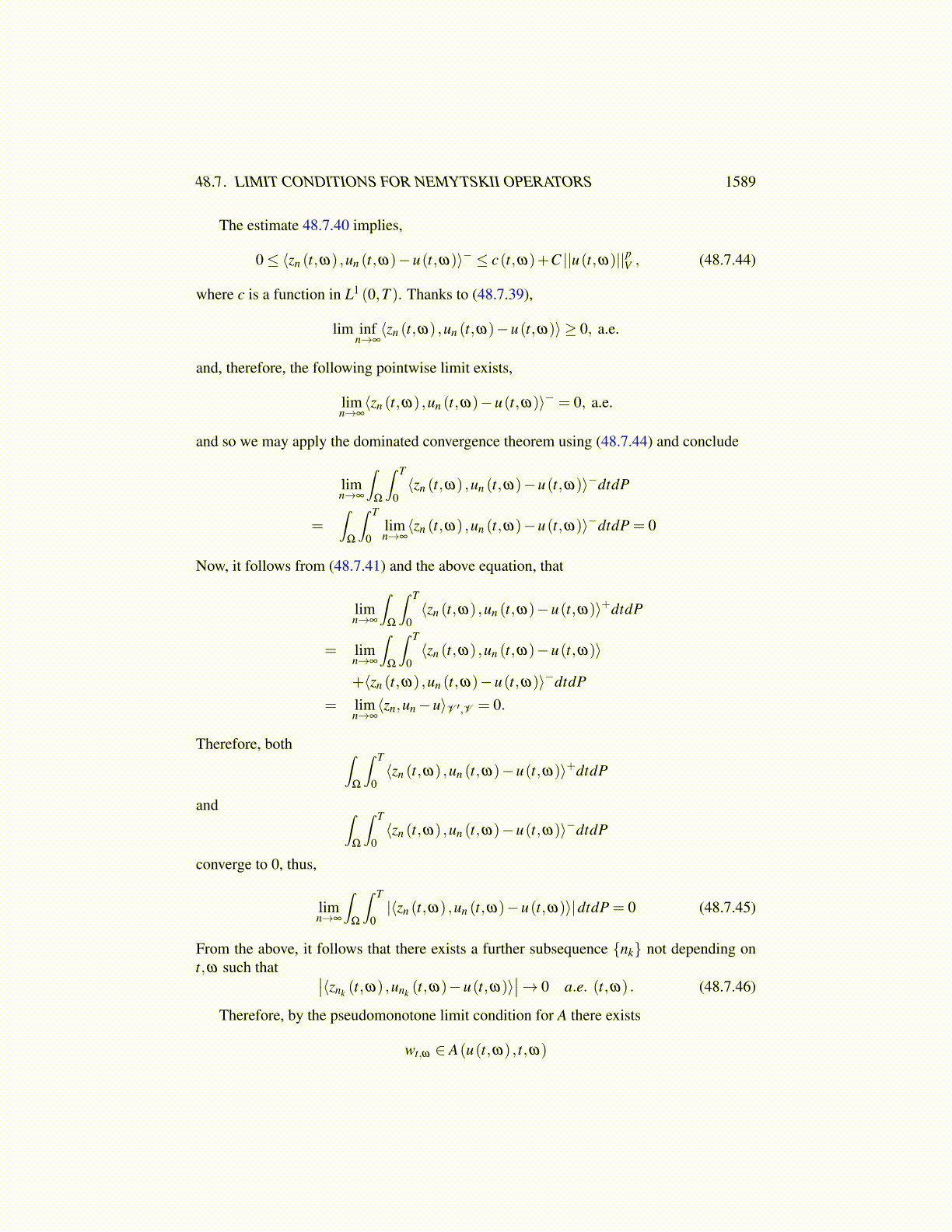
48.7. LIMIT CONDITIONS FOR NEMYTSKII OPERATORS 1589
≤(
b1∣∣∣∣unk (t,ω)
∣∣∣∣p−1V +b2 (t,ω)
)||u(t,ω)||V ,
therefore,∣∣∣∣unk (t,ω)
∣∣∣∣V and consequently
∣∣∣∣znk (t,ω)∣∣∣∣
V ′ are bounded. This follows from48.7.35. Note that
∣∣∣∣znk (t,ω)∣∣∣∣
V ′ is bounded independently of nk because of the assumptionthat A(·, t,ω) is bounded and we just showed that
∣∣∣∣unk (t,ω)∣∣∣∣
V is bounded.Taking a further subsequence if necessary, let unk (t,ω)→ u(t,ω) weakly in U ′ and
unk (t,ω)→ ξ weakly in V . Thus, by density considerations, ξ = u(t,ω). Now, 48.7.37and the limit conditions for pseudomonotone operators imply that the liminf conditionholds.There exists z∞ ∈ A(u(t,ω) , t,ω) such that
lim infk→∞⟨znk (t,ω) ,unk (t,ω)−u(t,ω)⟩ ≥ ⟨z∞,u(t,ω)−u(t,ω)⟩= 0
> limk→∞⟨znk (t,ω) ,unk (t,ω)−u(t,ω)⟩,
which is a contradiction. This completes the proof of the claim.We continue with the proof of the theorem. It follows from this claim that for given ω,
every t /∈ Σω ,lim inf
n→∞⟨zn (t,ω) ,un (t,ω)−u(t,ω)⟩ ≥ 0. (48.7.39)
Also, it is assumed thatlim sup
n→∞
⟨zn,un−u⟩V ≤ 0.
Then from the estimates,∫Ω
∫ T
0
(b3 ||un (t,ω)||pV −b4 (t,ω)−λ |un (t,ω)|2H
)dtdP
≤∫
Ω
∫ T
0∥u(t,ω)∥V
(∥un (t,ω)∥p−1 b1 +b2
)dtdP
so it is routine to get ∥un∥V is bounded. This follows from the assumptions, in particular48.7.35.
Now, the coercivity condition 3 shows that if y ∈ V , then
⟨zn (t,ω) ,un (t,ω)− y(t,ω)⟩ ≥ b3 ||un (t,ω)||pV −b4 (t,ω)−λ |un (t,ω)|2H−(
b1 ||un (t,ω)||p−1 +b2 (t,ω))||y(t,ω)||V .
Using p−1 = pp′ , where 1
p +1p′ = 1, the right-hand side of this inequality equals
b3 ||un (t,ω)||pV −b4 (t,ω)−b1 ||un (t,ω)||p/p′ ||y(t,ω)||V−b2 (t,ω) ||y(t,ω)||V −λ |un (t,ω)|2H ,
the last term being bounded independent of t,n by assumption. Thus there exists c(·, ·) ∈L1 ([0,T ]×Ω) and a positive constant C such that
⟨zn (t,ω) ,un (t,ω)− y(t,ω)⟩ ≥ −c(t,ω)−C ||y(t,ω)||pV . (48.7.40)